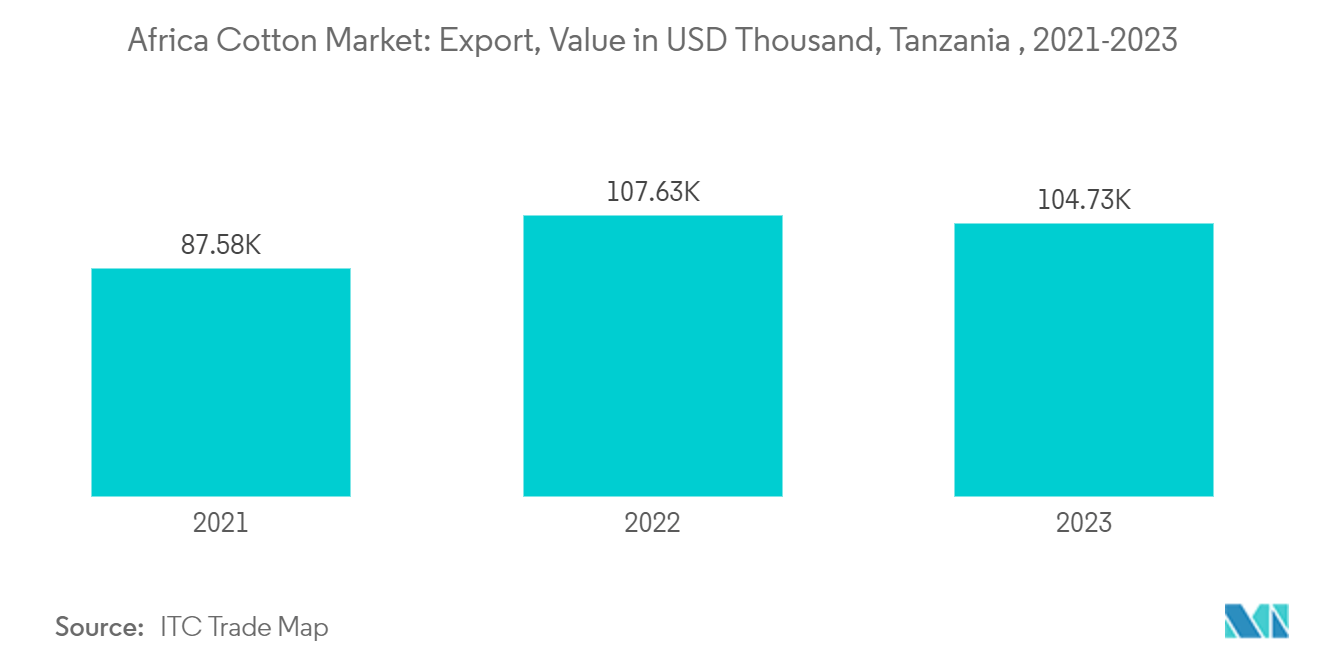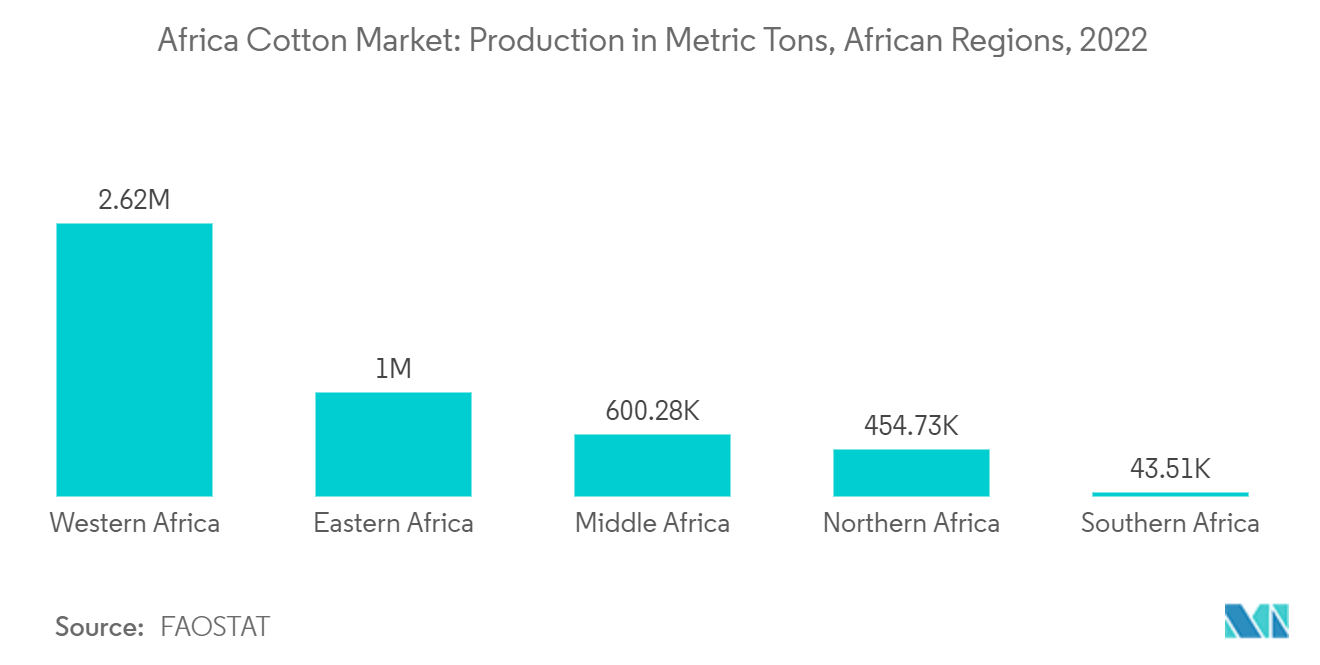Africa Cotton Market Size

| Study Period | 2019 - 2030 |
| Base Year For Estimation | 2024 |
| Forecast Data Period | 2025 - 2030 |
| Historical Data Period | 2019 - 2023 |
| Market Size (2025) | USD 6.36 Billion |
| Market Size (2030) | USD 8.08 Billion |
| CAGR (2025 - 2030) | 4.91 % |
Africa Cotton Market Analysis
The Africa Cotton Market size is estimated at USD 6.36 billion in 2025, and is expected to reach USD 8.08 billion by 2030, at a CAGR of 4.91% during the forecast period (2025-2030).
- Cotton grows well in a warm and moist climate where summer is long, and there is soil salinity, making Sub-Saharan Africa one of the largest cotton producers worldwide. Additionally, the crop has generally grown alternately and as in crop rotation with other crops, such as the basic food crops like maize, soy, or groundnuts, which reduces soil leaching and pests supporting its cultivation in the country. Beyond farming, the cotton industry supports textile manufacturing, spinning mills, and garment production, further contributing to economic development and driving the market's growth. Cottonseed is also used to extract edible oil, mainly in West Africa, for animal feed and products like margarine.
- Cotton is almost entirely cultivated by smallholder farmers in Africa, with very few major plantations. The crop is frequently farmed as a supplemental commercial crop alongside staples grown for subsistence. However, only in a few places in Africa is the genetically modified cotton crop permitted to grow. Smallholder farmers exclusively plant genetically modified cotton in South Africa, Sudan, and Burkina Faso in Sub-Saharan Africa. African cotton farmed by smallholder farmers is primarily hand-picked, ensuring its high quality. Along with this, organizations like Fairtrade Africa work to ensure fair prices and labor standards for cotton farmers, promoting sustainable practices in cotton production.
- Benin, Mali, Burkina Faso, and Côte d'Ivoire are the highest cotton-producing countries in Africa and account for about 50% of the region's produce. Cotton produced in Africa is majorly exported to Bangladesh, Vietnam, China, and Malaysia. Moreover, a new study produced by AKADEMIYA2063 and the International Food Policy Research Institute (IFPRI) in 2023 showed that Africa’s cotton value chains nonetheless hold significant potential to become Africa’s next major export commodity, delivering growth, improved livelihoods, and opportunities for the continent at large. Thus, the high potential of cotton in the African market, coupled with the significant exports and usage of sustainable farming practices, are driving the market's growth during the forecast period.
Africa Cotton Market Trends
Increasing Demand for African Cotton in the Textile Industry
- Cotton is a vital raw material for the African textile industry and is used to make yarns and fabrics for clothing and other products. The textile industry's increasing utilization of natural fibers, such as cotton, is driving the export of cotton from African countries. For instance, the export of cotton yarn from Tanzania accounted for USD 87,575 thousand in 2021, which grew to USD 104,725 in 2023, as per the ITC trade map data. The bolstering exports of cotton yarn is supporting the market's growth.
- The Cotton Made in Africa (CmiA) program run by the Aid by Trade Foundation received official recognition by the German Green Button standard as a sustainable natural fiber,' and was confirmed as an accredited source of raw materials by Cradle to Cradle Certified. It is likely to further boost CmiA uptake volumes through demand from existing and new program partners and apparel brands and retailers. The program's success in increasing cotton usage in the textile industry is boosting the market's growth.
- Along with this, the revision of the agreements between Sub-Saharan Africa and the United States benefits the African cotton market. The African Growth and Opportunity Act (AGOA) focuses on growing commerce in Sub-Saharan Africa and includes 34 African countries, such as Namibia and Rwanda. This statute makes African products, including cotton, appealing and accessible by allowing them to be included in duty-free shops worldwide, thereby expanding the market for cotton. The program was eligible till 2024 but was recently extended till 2025. Thus, the growing potential of cotton in the textile industry is aided by supportive initiatives, growing exports, and trade agreements, which are further driving the market's growth.

Western Africa Dominates the Production in the Region
- Western Africa comprises twelve cotton-producing countries, namely, Benin, Burkina Faso, Cameroon, Central African Republic, Chad, Côte d'Ivoire, Ghana, Mali, Niger, Nigeria, Senegal, and Togo. The Foreign Agricultural Service of the USDA reported that of the twelve nations, Côte d'Ivoire and Burkina Faso are the largest producers, and production in these areas is expected to grow during the study period. Among those countries, Mali recorded its highest cotton production of more than 526,000 metric tons in 2022, as per FAOSTAT. The high production of these countries in the region supports the cotton market.
- Along with this, Western Africa accounts for more than three-fourths of Africa's cotton exports. This is due to the high consumption in South and Southeast Asia, which are the major importers of West African cotton. Additionally, all West African cotton is exported, as mills are relatively sparse within the region, signifying the pivotal role that foreign demand plays for West African producers. This robust growth supports the region's high production compared to other parts. The production of cotton in Western Africa, Middle Africa, Northern Africa, Southern Africa, and Eastern Africa is 2,617,129 metric tons, 600,275 metric tons, 454,731 metric tons, 43,513 metric tons, and 1,000,643 metric tons, respectively. Thus, Western African countries lead the production of cotton.
- Cotton production has a chemically intensive production system that harms human and environmental health. In Western Africa, initiatives are being taken to increase organic cotton production. In 2023, Better Cotton started a new program to expand cotton production in Côte d'Ivoire and support 200,000 domestic cotton farmers in the first five years. The new field-level program is expected to offer training and resources to farming communities across the country to help them produce sustainable cotton. This is anticipated to increase the demand for Western African cotton in the forecast period. Therefore, the high production in West African countries compared to others, followed by supportive initiatives, drives the production in the region during the forecast period.

Africa Cotton Market News
- February 2024: Cotton Made in Africa (CmiA) partnered with Avon, a subsidiary of Natura & Co, a prominent Brazilian cosmetics conglomerate. In line with Avon's robust sustainability goals, the collaboration emphasizes a shift towards renewable materials in its supply chain, aiming to enhance the eco-credentials of its products. This strategic alliance with CmiA signifies a pivotal move in Avon's journey toward cotton sustainability.
- February 2024: The World Trade Organization (WTO) and football’s apex FIFA partnered and launched a new brand to strengthen the WTO-FIFA cotton partnership and support African countries’ participation in cotton trade value chains.
- December 2023: CIRAD, the Center for International Cooperation in Agricultural Research for Development, initiated the AIRCoA project. This project focuses on three key scientific innovations for smallholder cotton farmers in Africa: developing climate-resilient cotton varieties, soil rejuvenation through carbon capture, and adopting botanical biopesticides.
Africa Cotton Market Report - Table of Contents
1. INTRODUCTION
1.1 Study Assumptions and Market Definition
1.2 Scope of the Study
2. RESEARCH METHODOLOGY
3. EXECUTIVE SUMMARY
4. MARKET DYNAMICS
4.1 Market Overview
4.2 Market Drivers
4.2.1 Rising Area Under Cotton Production
4.2.2 Increasing Export Value of African Cotton
4.2.3 Increasing Supportive Intiatives
4.3 Market Restraints
4.3.1 High Prevalance of Pests and Diseases
4.3.2 Limited Access to Credit for Farmers
4.4 Value Chain Analysis
5. MARKET SEGMENTATION
5.1 Geography (Production Analysis by Volume, Consumption Analysis by Volume and Value, Import Analysis by Value and Volume, Export Analysis by Value and Volume, and Price Trend Analysis)
5.1.1 Benin
5.1.2 Mali
5.1.3 Burkina Faso
5.1.4 Côte d'Ivoire
5.1.5 Cameroon
5.1.6 Nigeria
5.1.7 Tanzania
6. MARKET OPPORTUNITIES AND FUTURE TRENDS
Africa Cotton Industry Segmentation
Cotton, a staple in the African textile industry, belongs to the Mallow family. Its cream-colored fluffy fibers, enveloping tiny seeds known as bolls, are processed by separating the small, sticky seeds from the wool before spinning and weaving. The African cotton market is segmented by Geography (Benin, Mali, Burkina Faso, Côte d'Ivoire, Cameroon, Nigeria, and Tanzania). The report includes production (volume), consumption (volume and value), import (volume and value), export (volume and value), and price trend analysis. The report offers the market size and forecasts in terms of volume (metric tons) and value (USD) for all the above segments.
| Geography (Production Analysis by Volume, Consumption Analysis by Volume and Value, Import Analysis by Value and Volume, Export Analysis by Value and Volume, and Price Trend Analysis) | |
| Benin | |
| Mali | |
| Burkina Faso | |
| Côte d'Ivoire | |
| Cameroon | |
| Nigeria | |
| Tanzania |
Africa Cotton Market Research FAQs
How big is the Africa Cotton Market?
The Africa Cotton Market size is expected to reach USD 6.36 billion in 2025 and grow at a CAGR of 4.91% to reach USD 8.08 billion by 2030.
What is the current Africa Cotton Market size?
In 2025, the Africa Cotton Market size is expected to reach USD 6.36 billion.
What years does this Africa Cotton Market cover, and what was the market size in 2024?
In 2024, the Africa Cotton Market size was estimated at USD 6.05 billion. The report covers the Africa Cotton Market historical market size for years: 2019, 2020, 2021, 2022, 2023 and 2024. The report also forecasts the Africa Cotton Market size for years: 2025, 2026, 2027, 2028, 2029 and 2030.
Cotton in Africa Industry Report
Statistics for the 2025 Africa Cotton market share, size and revenue growth rate, created by Mordor Intelligence™ Industry Reports. Africa Cotton analysis includes a market forecast outlook for 2025 to 2030 and historical overview. Get a sample of this industry analysis as a free report PDF download.



